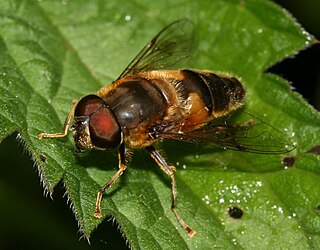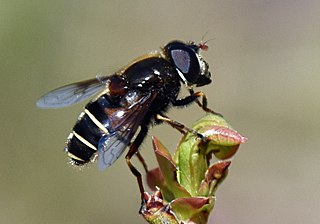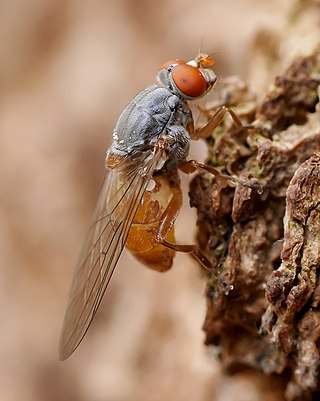| Eristalis horticola | |
|---|---|
 | |
| male | |
 | |
| female | |
| Scientific classification | |
| Kingdom: | |
| Phylum: | |
| Class: | |
| Order: | |
| Family: | |
| Genus: | |
| Subgenus: | |
| Species: | E. horticola |
| Binomial name | |
| Eristalis horticola | |
| Synonyms | |
Eristalis horticola is a Palearctic species of hoverfly.
| Eristalis horticola | |
|---|---|
 | |
| male | |
 | |
| female | |
| Scientific classification | |
| Kingdom: | |
| Phylum: | |
| Class: | |
| Order: | |
| Family: | |
| Genus: | |
| Subgenus: | |
| Species: | E. horticola |
| Binomial name | |
| Eristalis horticola | |
| Synonyms | |
Eristalis horticola is a Palearctic species of hoverfly.
Eristalis horticola is a medium-sized hoverfly species, with an average wing length between 8·25-11·5 millimeters. The fly's face is pale and dusted with a broad black median stripe. Other identifying characteristics include brown-black markings on the third segment of the antennomere, dull coloring on the second tergite segment, and yellowish spotting present along the abdomen.
Eristalis horticola wings are pigmented with dark clouding. This trait is more developed E. horticola females. In addition, the femur on the third pair of legs is pale at the base in males, and is pale on the basal half of these segments in females. [3] [4] [5] [6]
The larval form of this species is aquatic. [7]
This species has a palearctic distribution. They can be found at their northernmost point in southern areas of the Fennoscandian peninsula, down to the Mediterranean basin and North Africa. Their range also extends from Ireland and continues east, as far as the island of Sakhalin. In addition, populations of Eristalis horticola have been found in India. [8] [9]
Eristalis horticola can be found in areas where water is consistently present, such as wetland habitats, deciduous forests, temperate coniferous forests, taigas, montane tundras, fens, and cut-over valley bogs. They can also be found at the margins of pools, streams and rivers. [10]
Like other hoverfly species, E. horticola feed on the nectar and pollen produced by flowers. These flowers include yellow composites, white umbellifers, Compositae, Ranunculaceae, and Umbelliferae, Calluna vulgaris, Cardamine, Cirsium, Crataegus, Eupatorium, Galium, Jasione, Pyrus communis, Ranunculus, Rubus fruticosus, Rubus idaeus, Sambucus, Sorbus aucuparia, Stellaria, Succisa, and Viburnum opulus. [11]
This species can be found flying from May to September.
The scientific name of this species was published as Musca horticola in 1776 by Charles De Geer. [12] The name has been in general use as Eristalis horticola (De Geer, 1776) in the two centuries following its publication. On the basis of a colour plate of Musca lineata by Moses Harris, also published in 1776, the latter name was generally accepted as a junior synonym of Musca horticola.
At the end of the twentieth century, some entomologists noted that De Geer erroneously listed Musca nemorum (Linnaeus, 1758) as a synonym under Musca horticola, which would invalidate the name. As a result of some confusion about the type material of Musca nemorum, some entomologists already regarded that name as a synonym of Musca arbustorum (Linnaeus, 1758.) [13] The same authors placed Musca horticola in the synonymy of Eristalis arbustorum. They proposed to use the next available scientific names for both species, and to use the name Eristalis interrupta (Poda, 1761) for the species known until then as Eristalis nemorum, and to use the name Eristalis lineata (Harris, 1776) for the species known as Eristalis horticola for over two centuries. In 2004, entomologists Peter Chandler, Andrew Wakeham-Dawson and Angus McCullough submitted a request to the International Commission on Zoological Nomenclature to conserve both names with a neotype. [14] The request was granted less than two years after its submission. [15] In various overviews, including Fauna Europaea, the names proposed by Thompson et al. are still published. [16]

Eristalis is a large genus of hoverflies, family Syrphidae, in the order Diptera. Several species are known as drone flies because they bear a resemblance to honeybee drones.

Eristalis pertinax is a hoverfly in the family Syrphidae. It was first described by Giovanni Antonio Scopoli in 1763 and is found in Asia and Europe. Like Eristalis tenax, the larvae of E. pertinax are rat-tailed maggots living in drainage ditches, pools around manure piles, sewage, and similar places containing water with high organic load and low oxygen concentration.

Eristalis arbustorum, the European drone fly, is an abundant Northern Hemisphere species of syrphid fly, originally officially described by Linnaeus in 1758 as Musca arbustorum. The name "drone fly" is related to its similar appearance to the drone of the honeybee. Hoverflies get their names from the ability to remain nearly motionless while in flight. The adults are also known as flower flies as they are commonly found on and around flowers from which they get both energy-giving nectar and protein rich pollen. The larvae are aquatic filter-feeders of the long-tailed type.

Eristalis nemorum is a species of hoverfly. It is found in the Palearctic and in the Nearctic.

Chrysotoxum cautum is a species of hoverfly. It is found in southern Britain and Europe East into the Palearctic but is normally encountered in small numbers. The larvae are thought to feed on root aphids. Adults are usually found on the edges of woodland or scrub or along hedgerows where they visit a wide range of flowers.

Myathropa florea, sometimes referred to as the Batman hoverfly, is a very common European and North African species of hoverfly. Adults may be seen on flowers from May to September. It is of a similar size to the common drone fly, but Myathropa are generally more yellow, with two light bands to the thorax, interrupted with a black central smudge. In museum specimens, any yellow colour soon fades to brown after death. Like most species in the tribe Eristalini, Myathropa are rather variable in size, shape and colour.

Eristalis intricaria is a European species of hoverfly. It is a furry bee mimic, superficially resembling Merodon, though Merodon have all black leg tibiae, as opposed to partly yellow. E. intricaria is somewhat variable in colour pattern, and some attempts at naming varieties have been tentatively made. Flight time of adults in the UK are from March to September. It is generally widespread, but is seldom seen in large numbers. Habitat is woodland or marshland.

Parasyrphus punctulatus is a Palearctic species of hoverfly.

Eristalis abusiva is a European species of hoverfly. It is similar to Eristalis arbustorum.

Eristalis cryptarum is a holarctic species of hoverfly. Known as the bog hoverfly or bog-dwelling drone fly, it is a bog specialist but may occur in other wetlands. Its larvae are assumed to live in peat that is saturated with water, such as that found in these boggy areas. The female has been observed depositing eggs on and close to very fresh cow dung along oligotrophic seepages in moorland.

Microdon mutabilis, is a species of hoverfly. It is found in many parts of Britain and Europe. The distinctive almost slug-like larvae live in ants' nests. They are hemispherical in shape, heavily armoured and believed to prey on the eggs and larvae of a number of ant species, including Formica lemani, Formica fusca, Lasius niger and Myrmica ruginodis. It was described by Carl Linnaeus in his landmark 1758 10th edition of Systema Naturae.

Anasimyia lineata is a Palaearctic species of hoverfly.
Anasimyia transfuga is a Palearctic species of hoverfly.

Parhelophilus consimilis is a Palearctic hoverfly.

Chrysotoxum festivum is a species of hoverfly.
Chrysotoxum fasciatum is a species of Holarctic hoverfly.

Brachyopa insensilis is a Palearctic species of hoverflies.

Neoascia obliqua is a Palearctic species of hoverfly.
Chamaesyrphus caledonicus is a Palearctic hoverfly.